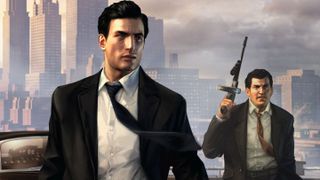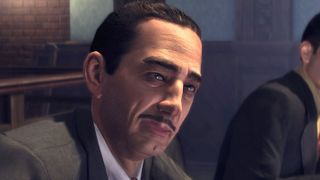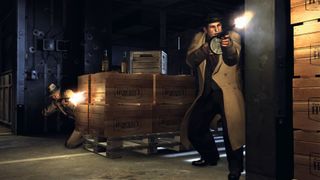Why Mafia 2's ambitious mob tale is worth a revisit
REINSTALL
Reviews for Mafia II were mixed.


Reinstallinvites you to join us in revisiting PC gaming days gone by. Today, Andy slicks back his hair and returns to the criminal underworld of Mafia 2.
Reviews for Mafia II were mixed. Most of the negative ones complained that, compared to Grand Theft Auto, its open world was sterile and empty. But they were missing the point. If you play Mafia expecting GTA with hats, you’re going to be disappointed. Play it as a story-led linear shooter and it’s one of the best examples on PC.
The city is there, sure, but it’s really just a backdrop. A detailed film set designed to give the story a rich sense of place. Empire Bay is a local corner shop to GTA V’s giant department store, but it’s still one of the best virtual cities in videogaming. It’s fictional, based loosely on New York City, but the artists at 2K Czech did a remarkable job of making it feel like a real place with its own history, culture and inner life.
Workers mill around the docks, unloading cargo from ships. Cherry trees in blossom sway in the breeze in Chinatown. From the suburbs of Hunters Point you can see the skyscrapers of downtown Empire Bay looming in the distance. It’s not littered with side missions and crazy vehicles to steal, but it’s a fantastic place just to explore and soak it all in.

It didn’t take me long to fall in love with Mafia II. The second mission, in fact. Protagonist Vito Scaletta returns from World War II on a cold winter’s evening and finds himself back in the neighbourhood where he grew up. Dean Martin’s Christmas classic ‘Let It Snow’ plays as he walks the old, snowy streets of Little Italy, reminiscing with faces from his past. Military planes fly overhead, reminding us that the war is far from over. We see couples arguing, kids throwing snowballs, and a guy getting a haircut in a barbershop. It’s a wonderful piece of scene-setting, bringing to life not just a different world but a different time.
Mafia II is a rare example of an open-world game where we see two versions of the same city. The first portion of the game takes place in Empire Bay in the 1940s. The mood is gloomy, snow piling up on cars and sidewalks, people slipping on icy pavements, and an almost palpable chill in the air. It’s here that Vito begins climbing the criminal ladder, working with his old pal, Joe Barbaro. As in GTA, you start off at the lowest level, pulling off smalltime heists, selling stolen goods, and performing other odd-jobs. But then something goes wrong, and Vito ends up in jail for six years.
These years serve as an interlude of sorts. You’re confined to the prison, which is another example of 2K Czech’s amazing world-building. You get to know other inmates, make friends with a respected mafia boss who’s doing his own time, and make a powerful enemy in the form of a hulking Irish brute called Brian O’Neill. It’s like The Shawshank Redemption meets the prison scenes from Goodfellas. This sequence also marks the first time a game has ever made me clean a toilet.
You can dress Vito up in fashionable post-war suits, scream around in shiny sports cars, and fire Tommy guns at people.
Vito emerges from prison to find a very different Empire Bay. The year is 1951, and the city is no longer bleak and snowy: it’s bright, colourful, and green. Teenagers screech around in hot rods listening to Buddy Holly and girls wear revealing dresses. “It was like a whole new world,” muses Vito’s narration as he takes a cab to Joe’s house. I always miss the wintry ’40s setting when I get to this point in the game. The ’50s stuff is undeniably cool, and feels much more lively, but it’s not nearly as atmospheric.
The music and commercials on the radio also change to reflect each time period. From The Andrews Sisters and Bing Crosby in the 1940s to Little Richard and Bill Haley in the ’50s, the game boasts a superb selection of period music. I don’t know how authentic it really is—I was born in the ’80s—but Mafia II brilliantly captures a sense of that time in American history: both the glamour and the tragedy. It pulls surprisingly few punches when dealing with racism, poverty and other issues that plagued the period, which is something Mafia III is tackling more directly.
But it’s also an unashamed gangster power fantasy. As his bank balance increases, you can dress Vito up in fashionable post-war suits, scream around in shiny sports cars, and fire Tommy guns at people. As he rises in the ranks, his safehouses get more lavish, from scummy, ratinfested apartments to a dream ’50s house, complete with pastel-coloured furniture. Mafia II may touch on real history, but it’s an exaggerated, pulpy, almost comic book tale of warring gangs and criminal conspiracy. It’s a good one, though, with a plot that keeps you interested throughout its 12 or so hours.

Vito is not a sympathetic character. He is, after all, a ruthless criminal. But you warm to him just the same. His sidekick Joe can veer a little too much into comic relief territory, but for the most part he’s likeable. The rest of the cast are most forgettable mafioso stereotypes, with a few exceptions, but this remains a solidly written and well-acted game. And if you get bored of the story, there are always the genuine ’50s Playboy centrefolds scattered around the city to find, which feature actual ladies’ boobs. Rude!
Another great moment, much later in the game, involves another Dean Martin song. This time it’s popular romantic ballad ‘Return To Me’. Vito drives Joe and another character to bury a body in the countryside. They’re both drunk, and as you drive, they start singing along. When it gets to the Italian verse, they mumble, too embarrassed to admit they don’t know the words. Mafia II is a funny game when it wants to be, with a sense of humour similar to Scorsese’s gangster flicks. These moments of comedy break up the action, and stop it from becoming too repetitive—although later shootouts can be a seemingly endless slog of popping in and out of cover.
Mafia II is fundamentally a generic shooter, and the car handling is twitchy, making some of its chases frustrating. But it makes up for it with variety, personality, and a rich, well-realised setting. GTA does almost everything it does better and on a larger scale, but Mafia’s story is arguably more compelling. Don’t think of it as an open-world game, because it really isn’t. Come at it from the right angle, as a linear, scripted, but enjoyable shooter, and you might find you love it.
Post a Comment